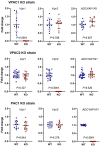VPAC1 and VPAC2 receptors mediate tactile hindpaw hypersensitivity and carotid artery dilatation induced by PACAP38 in a migraine relevant mouse model
- PMID: 39085771
- PMCID: PMC11293201
- DOI: 10.1186/s10194-024-01830-2
VPAC1 and VPAC2 receptors mediate tactile hindpaw hypersensitivity and carotid artery dilatation induced by PACAP38 in a migraine relevant mouse model
Abstract
Background: Pituitary adenylate cyclase-activating peptide (PACAP) is a neuropeptide pivotal in migraine pathophysiology and is considered a promising new migraine drug target. Although intravenous PACAP triggers migraine attacks and a recent phase II trial with a PACAP-inhibiting antibody showed efficacy in migraine prevention, targeting the PACAP receptor PAC1 alone has been unsuccessful. The present study investigated the role of three PACAP receptors (PAC1, VPAC1 and VPAC2) in inducing migraine-relevant hypersensitivity in mice.
Methods: Hindpaw hypersensitivity was induced by repeated PACAP38 injections. Tactile sensitivity responses were quantified using von Frey filaments in three knockout (KO) mouse strains, each lacking one of the PACAP-receptors (Ntotal = 160). Additionally, ex vivo wire myography was used to assess vasoactivity of the carotid artery, and gene expression of PACAP receptors was examined by qPCR.
Results: PACAP38 induced hypersensitivity in WT controls (p < 0.01) that was diminished in VPAC1 and VPAC2 KO mice (p < 0.05). In contrast, PAC1 KO mice showed similar responses to WT controls (p > 0.05). Myograph experiments supported these findings showing diminished vasoactivity in VPAC1 and VPAC2 KO mice. We found no upregulation of the non-modified PACAP receptors in KO mice.
Conclusions: This study assessed all three PACAP receptors in a migraine mouse model and suggests a significant role of VPAC receptors in migraine pathophysiology. The lack of hypersensitivity reduction in PAC1 KO mice suggests the involvement of other PACAP receptors or compensatory mechanisms. The results indicate that targeting only individual PACAP receptors may not be an effective migraine treatment.
Keywords: Knockout mice; Migraine; PAC1; PACAP; VPAC1; VPAC2; von Frey.
© 2024. The Author(s).
Conflict of interest statement
The authors declare no competing interests.
Figures






References
-
- Charles A, Pozo-Rosich P (2019) Targeting calcitonin gene-related peptide: a new era in migraine therapy. The Lancet, vol 394. Lancet Publishing Group, pp 1765–1774 - PubMed
MeSH terms
Substances
LinkOut - more resources
Full Text Sources
Medical
Research Materials

